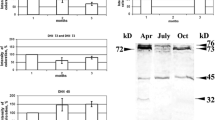Abstract
Hill reaction and noncyclic photophosphorylation of isolated class C chloroplasts of spruce (Picea abies (L.) Karst.), as well as 14CO2 fixation by whole needles at constant laboratory conditions proceeded at high rates during spring and early summer, declined during late summer and autumn by about 60%, remained at this level during winter, and recovered quickly in early spring. During summer, the whole needles proved to be frost labile, since after exposure to-20°C and careful thawing, fast chlorophyll degradation occurred. In addition, only photosynthetically inactive chloroplasts could be isolated from those precooled needles. On the contrary, during winter the photochemical activities of plastids from freshly harvested needles did not differ from those of artificially frozen-thawed needles. When isolated spruce chloroplasts were exposed to the same subfreezing temperatures as the whole needles, no influence of freezing on the photochemical activities was observed, irrespective of whether the plastids were isolated from frost sensitive or frost hardened needles. It is concluded that frost damage to spruce chloroplasts is due to an attack of membrane toxic compounds or lytic enzymes which were liberated upon freezing from more labile compartments. Frost hardening of the chloroplasts, as determined by the stability of chlorophyll after exposure of the needles to low temperatures, as well as by the isolation of photosynthetically active chloroplasts from such precooled needles, appeared to depend at least on 2 processes: (i) an alteration of the composition of the photosynthetically active membranes and (ii) and additional stabilization of these membranes by protecting substances. The first process was indicated by a large increase (decrease) of the capability of isolated chloroplasts for PMS-mediated photophosphorylation which accompanied natural or artificial frost hardening (dehardening). Production of cryoprotecting compounds was suggested by a significant higher stability against NaCl observed with class C chloroplasts isolated from frost hardened needles as compared to that of plastids from frost labile material. The decrease of the capability for both, the ferricyanide dependent photoreactions of the plastids and the CO2 fixation by whole needles, which was observed during the frost hardening phase, cannot be due to freezing injuries; it rather appears to be a consequence of the frost hardening process.
Similar content being viewed by others
References
Arnon, D.I.: Copper enzymes in isolated chloroplasts. Polyphenol oxidase in Beta vulgaris. Plant Physiol. 24, 1–15 (1949)
Bauer, H., Huter, M., Larcher, W.: Der Einfluß und die Nachwirkung von Hitze und Kältestreß auf den CO2-Gaswechsel von Tanne und Ahorn. Ber. Deutsch. Bot. Ges. 82, 65–70 (1969)
Hall, D.O.: Nomenclature for isolated chloroplasts. Nature New Biol. 235, 125–126 (1972)
Heber, U., Santarius, K.A.: Loss of adenosine triphosphate synthesis caused by freezing and its relationship to frost hardiness problems. Plant Physiol. 39, 712–719 (1964)
Heber, U.: Freezing injury and uncoupling of phosphorylation from electron transport in chloroplasts. Plant Physiol. 42, 1343–1350 (1967)
Heber, U., Tyankova, L., Santarius, K.A.: Effects of freezing on biological membranes in vivo and in vitro. Biochim. Biophys. Acta 291, 23–37 (1973a)
Heber, U., Santarius, K.A.: Cell death by cold and heat and resistance to extreme temperatures. Mechanisms of hardening and dehardening. In: Temperature and Life p. 232–263 (H. Precht, J. Christophersen, H. Hensel, W. Larcher, eds.), Berlin-Heidelberg-New York: Springer 1973 (b)
Kandler, O.: Möglichkeiten zur Verwendung von 14C für chemotaxonomische Untersuchungen. Ber. Deutsch. Bot. Ges. 77, 62–73 (1964)
Lange, O.L.: Die Hitzeresistenz einheimischer immer- und wintergrüner Pflanzen im Jahreslauf. Planta 56, 666–683 (1961)
Larcher, W.: Temperature resistance and survival. In: Temperature and Life p. 203–231 Precht, H., Christophersen, J., Hensel, H., Larcher, W. eds. Berlin-Heidelberg-New York: Springer 1973
Levitt, J.: Frost drought, and heat resistance Protoplasmatologia Bd VIII/6 Wien: Springer 1958
Levitt, J.: Responses of plants to environmental stresses. New York-London: Academic Press 1972
Lovelock, J.E.: The mechanism of the protective action of glycerol against haemolysis by freezing and thawing. Biochim. Biophys. Acta 11, 28–36 (1953)
Parker, J.: Seasonal changes in white pine leaves: A comparison of cold resistance and free-sugar fluctuations. Bot. Gaz. 121, 46–50 (1959)
Pisek, A., Larcher, W.: Zusammenhang zwischen Austrocknungsresistenz und Frosthärte bei Immergrünen. Protoplasma 44, 40–46 (1954)
Pisek, A., Winkler, E.: Assimilationsvermögen und Respiration der Fichte (Picea excelsa Link) in verschiedener Höhenlage und der Zirbe (Pinus cembra L.) an der alpinen Waldgrenze. Planta 51, 518–543 (1958)
Pisek, A., Larcher, W., Unterholzner, R.: Kardinale Temperaturbereiche der Photosynthese und Grenztemperaturen des Lebens der Blätter verschiedener Spermatophyten. I. Temperaturminimum der Nettoassimilation, Gefrier- und Frostschadenbereiche der Blätter. Flora 157, 239–264 (1967)
Schreiber, B.: Some electrochemical properties on a simplified biological membrane model. Effects of some N-substituted phenothiazines and quaternary ammonium salts. Bioelectrochem. Bioenerg. 1, 355–363 (1974)
Senser, M., Dittrich, P., Kandler, O., Thanbichler, A., Kuhn, B.: Isotopenstudien über den Einfluß der Jahreszeit auf den Oligosaccharidumsatz bei Coniferen. Ber. Deutsch. Bot. Ges. 84, 445–455 (1971)
Senser, M., Schötz, F., Beck, E.: Seasonal changes in structure and function of spruce chloroplasts. Planta 126, 1–10 (1975)
Trebst, A., Hauska, G.: Energiekonservierung in der photosynthetischen Membran der Chloroplasten. Naturwissenschaften 61, 308–316 (1974)
Author information
Authors and Affiliations
Rights and permissions
About this article
Cite this article
Senser, M., Beck, E. On the mechanisms of frost injury and frost hardening of spruce chloroplasts. Planta 137, 195–201 (1977). https://doi.org/10.1007/BF00388150
Received:
Accepted:
Issue Date:
DOI: https://doi.org/10.1007/BF00388150



